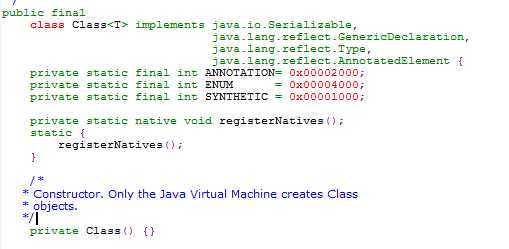标签:style blog http java color 使用
反射,reflection,听其名就像照镜子一样,可以看见自己也可以看见别人的每一部分。在java语言中这是一个很重要的特性。下面是来自sun公司官网关于反射的介绍:
Reflection is a feature in the Java programming language. It allows an executing Java program to examine or "introspect" upon itself, and manipulate internal properties of the program. For example, it‘s possible for a Java class to obtain the names of all its members and display them.
The ability to examine and manipulate a Java class from within itself may not sound like very much, but in other programming languages this feature simply doesn‘t exist. For example, there is no way in a Pascal, C, or C++ program to obtain information about the functions defined within that program.
One tangible use of reflection is in JavaBeans, where software components can be manipulated visually via a builder tool. The tool uses reflection to obtain the properties of Java components (classes) as they are dynamically loaded.
那么解释一下就是,反射是java语言的一个特性,它允程序在运行时(注意不是编译的时候)来进行自我检查并且对内部的成员进行操作。例如它允许一个 java的类获取他所有的成员变量和方法并且显示出来。这个能特定我们不常看到,但是在其他的比如C或者C++语言中很不就存在这个特性。一个常见的例子 是在JavaBean中,一些组件可以通过一个构造器来操作。这个构造器就是用的反射在动态加载的时候来获取的java中类的属性的。
反射的前传:类类型 Class Class
java中有一个类很特殊,就是Class类,很多朋友在写程序的时候有用 过比如Apple.class来查看类型信息,大家就可以把它理解为封装了类的信息,很多解释说Class类没有构造器,其实是有的,只不过它的构造方法 是private的(构造函数还有private的??有,这样是为了禁止开发者去自己创建Class类的实例)。我们可以看一下JDK中源码:

注释很明确的告诉了我们,这个类是有JVM来创建的,所以我们就不用麻烦了。如果我们拿到一个类的类型信息,就可以利用反射获取其各种成员以及 方法了。(注:Class 从JDK1.5版本后就开始更多为泛型服务了)那么我们怎么拿到一个类型的信息呢?假设我们有一个Role类:
1 package yui;
2
3 /**
4 * A base class having some attributes and methods
5 * @author Octobershiner
6 * @since 2012 3 17
7 *
8 * */
10 public class Role {
11
12 private String name;
13 private String type;
14
15 // Constructors
16 public Role(){
17 System.out.println("Constructor Role() is invoking");
18 }
19 //私有构造器
20 private Role(String name){
21 this.name = name;
22 System.out.println("Constructor Role(String name) is invoking.");
23 }
24
25 //get and set method
26
27 public String getName() {
28 return name;
29 }
30 public void setName(String name) {
31 this.name = name;
32 }
33 public String getType() {
34 return type;
35 }
36 public void setType(String type) {
37 this.type = type;
38 }
39
40 //override the toString method to show the class
41 @Override
42 public String toString(){
43 return "This is a role called "+this.name;
44 }
45
46 }
在没有对象实例的时候,主要有两种办法。
//获得类类型的两种方式
Class cls1 = Role.class;
Class cls2 = Class.forName("yui.Role");
注意第二种方式中,forName中的参数一定是完整的类名(包名+类名),并且这个方法需要捕获异常。现在得到cls1就可以创建一个Role类的实例了,利用Class的newInstance方法相当于调用类的默认的构造器
Object o = cls1.newInstance(); //创建一个实例
//Object o1 = new Role(); //与上面的方法等价
这样就创建了一个对象,缺点是我们只能利用默认构造函数,因为Class的newInstance是不接受参数的,后面会讲到可接受参数的newInstance,第二,如果类的构造函数是private的,比如Class,我们仍旧不能实例化其对象。
获 取类的构造器
首先介绍一下Constructor类,这个类用来封装反射得到的构造器,Class有四个方法来获得Constructor对象
1 /**
2 * 获取构造方法Constructor
3 * getConstructor() only for public
4 * getDeclaredConstructor() global access all
5 *
6 * */
7
8 //指定参数列表获取特定的方法
9 Constructor con = cls1.getDeclaredConstructor(new Class[]{String.class});
10 con.setAccessible(true); //设置可访问的权限
11 Object obj = con.newInstance(new Object[]{"liyang"});
12 System.out.println(obj); //打印一下这个对象的信息
13
14 //获取所有的构造方法集合
15 Constructor con1[] = cls1.getDeclaredConstructors();
16 con1[1].setAccessible(true);
17 Object obj1 = con1[1].newInstance(new Object[]{"tom"});
18 System.out.println(obj1);
1 /**
2 * 获取成员变量Field
3 * getField()
4 * getDeclaredField()
5 * */
6 Field mem = cls1.getDeclaredField("name");
7 mem.setAccessible(true);
8 System.out.println("we get form field :"+mem.get(obj));
9
1 /**
2 * 调用类的方法 Method
3 * getMethod()
4 * getDeclaredMethod()
5 *
6 * */
7 Method f = cls1.getMethod("getName", null);
8 Object name = f.invoke(obj, null);
9 System.out.println("we invoke method : "+ name);
请支持Java Taste 项目:https://github.com/octobershiner/Java-Taste
标签:style blog http java color 使用
原文地址:http://www.cnblogs.com/zhaoxinshanwei/p/3862162.html